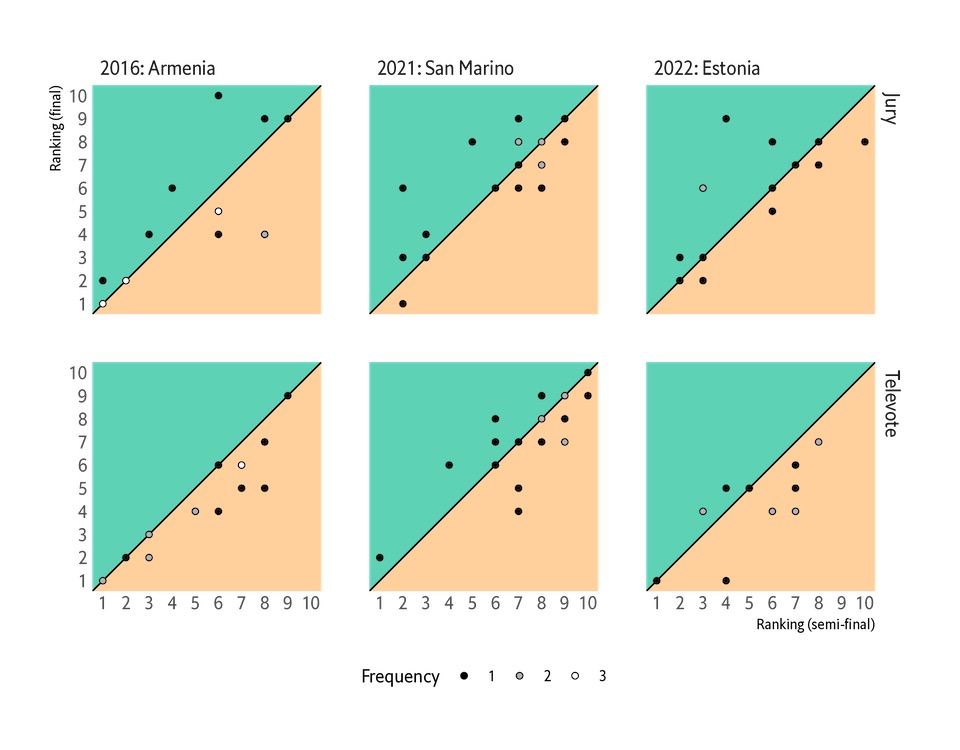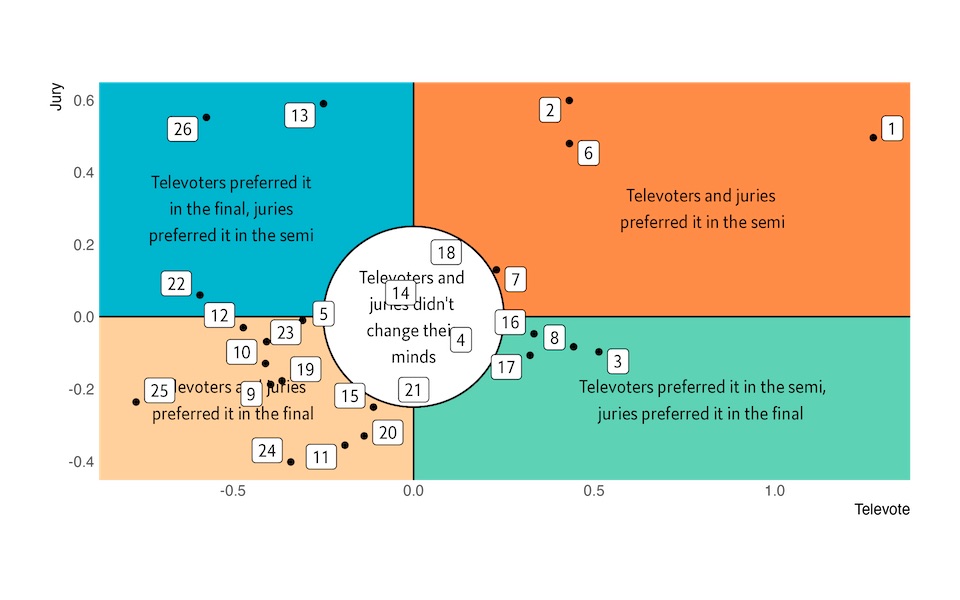Mae Muller will be performing in the final slot at this year’s Grand Final. Is this a bad slot? Ben Robertson noted in his analysis that, since 1998, the average final position – the ranking – for performances in the running order’s final slot is a bit higher than the average ranking overall – 11.8 as compared with 12.5 – and also noted that when we compare these acts’ rankings in the Grand Final with their rankings in the semi-final, they also tend to do a bit better.
Case closed?
Perhaps not…
What Are We Looking For?
A more accurate comparison is to look at the rankings that the acts in the Grand Final position received only from those countries who voted for them in the Semi Final. This means we can look at how many acts who closed the Grand Final improved their rankings with individual juries and televotes, how many lost ground, and how many were stable.
The EBU has published detailed voting results capturing televote and jury votes from the Semi Finals and Grand Finals since 2014. In those eight Contests, one of the Big Five has performed last five times; the UK in 2014, Italy in 2015 and 2018, France in 2017, and Spain in 2019. That leaves just three performances where we can draw this comparison: Armenia in 2016, San Marino in 2021, and Estonia in 2022.
Measuring Change
To recap, we’re looking just at those countries who voted on these acts’ performances in both the Sem Final and Grand Final. We’re looking at their relative rankings just of the acts that qualified from their Semi Final. So, for example, if a jury representing a Big Five country absolutely hated a given act both times they saw them, and put them in last place both times, they’d be ranked tenth of the countries that qualified – even if that corresponded to sixteenth in the Semi-Final and twenty-sixth in the Grand Final. A jury or televote can therefore keep the act in the same position, rank them more highly, or rank them less highly.
Of course, the difference between being ranked first versus second has a much greater impact on a performance than the difference between being ranked fourteenth versus fifteenth. But for the moment, let’s focus purely on the direction of the changes in 2016, 2021, and 2022.

Where points are on the diagonal line, that means that the jury or televote ranked the performance in the same relative position in both the Semi Final and the Grand Final. Up in the top right, we have performances that were ranked first both times: for example, Russia’s televote placed Armenia in first place in both shows. But most points aren’t on the diagonal line.
Where points are in the orange shaded area, that means that the jury or televote ranked the act higher in the Grand Final than in the Semi Final; where points are in the green shaded area, that means they were ranked lower on the Saturday night.
For example, Cyprus’ jury was much keener on Estonia in the 2022 Semi Final than they were in the final.
Let’s break out those numbers:
| Rises | Break-evens | Falls | |
| 2016: Armenia | 6 (J) / 11 (T) | 7 (J) / 7 (T) | 5 (J) / 0 (T) |
| 2021: San Marino | 6 (J) / 7 (T) | 6 (J) / 7 (T) | 7 (J) / 5 (T) |
| 2022: Estonia | 4 (J) / 9 (T) | 5 (J) / 2 (T) | 5 (J) / 3 (T) |
Overall, juries are roughly equally likely to rank a performance higher, lower, or the same, over the two shows, with 16 increases, 17 decreases, and 18 break-events. But we can see that it’s unusual for an act to do much better in the Grand Final among jurors. There are just two cases where a performance climbs more than two places: both France and Estonia were significantly keener on Armenia in the final than in the semi in 2016. On the flipside, acts dropped in juries’ rankings by more than two places six times.Big climbs are relatively uncommon among juries.Yet acts performing last in the running order do better with televoters. 27 national televotes ranked an act higher in the Grand Final relative to the Semi Final: in 16 cases, they stayed the same, and they did worse in just 8. This was most pronounced for Armenia in 2016: 11 televotes ranked Iveta Mukuchyan higher in the Saturday show, and not a single country ranked her lower. Among the falls, only two are drops of two places, and none at all are more severe.Last in the running order could mean a small boost from televoters, but could also mean a brake from juries.
What About Those Not Singing Last?
There are (usually) another 25 positions we’re interested in. Is performing second really a curse? Or could it be that a producer looking to entertain and engage the audience is unlikely to put a massively attractive act on second? In Melodifestivalen, Christer Bjorkman always liked to start the show with a bang, and the second song would bring the tempo down. The same could be true for the Eurovision Song Contest production team as well.
We can answer this question by applying the technique we’ve just used to every single running order position. We start with every act that has performed in both a semi-final and a grand final since 2014. We then look at their change in rankings among the other acts that qualified from their semi-final among the juries and televoters that voted on them both times and look at the average for each group. Finally, we take the average changes for each position.
This is easier to communicate with a picture. Let’s take a look.

In the middle, in white, running order positions of 4, 14, 18, and 21 had almost identical rankings among both televoters and juries in both the semis and the finals: an average change of a maximum of 0.3 positions among the 10 acts that went through from their semi. These are relatively neutral positions.
The positions you want to avoid are the ones in the top right, in dark orange. The first position is the weakest slot compared to a Semi Final performance. Among televoters, acts performing first dropped a full ranking position on average among televoters, and nearly half a ranking position on average among juries. Not a single act opening the show did better among televoters in the Grand Final: Mélovin in 2018 was the only one to break even, and even he lost ground among the juries.
On the other extreme are We Are Domi in 2022: they were the final performers in the second Semi Final, coming fourth, but after opening the grand final they came 22nd, with thirteen out of fourteen televoters dropping them in the rankings. Acts in second and sixth position also dropped by about half a ranking point among both jurors and televoters, so these are also slots that acts would want to avoid.
The bottom right, in blue, is where we find positions that televoters preferred in the semi and juries preferred in the final. We can find the third position here: this drops down televoters’ ranks about as much as second position, but juries are a bit warmer. This area also includes eighth, and a couple of the spots shortly after the interval: 16th and 17th.
The top left, in green, is the opposite: positions that televoters preferred in the final but that juries preferred in the semi. We can see 26th (or last) position here again, which should come as no surprise, but what’s interesting is that it’s very close to the 13th position, which is usually the final slot among the acts that have been allocated to the first half. The songs in 13th position are a real mix of styles: it’s hard to make many comparisons between ‘Better Love’, ‘My Friend’, and ‘Sound of Silence’.
Having won the jury vote overall, we might not think of Dami Im as an act who suffered among the jurors in the Grand Final. But she dropped in the rankings among seven juries, and didn’t increase in any. Maybe if she’d been in a different position in the running order in the Grand Final, we’d have had a different winner? Either way, acts performing in 13th or 26th drop by a full half ranking among their fellow semi-final qualifiers on average.
Finally, we have the bottom left in light orange, which is where we find acts that did better in the final among both jurors and televoters. The position that televoters reward the most is 25th, which is usually the penultimate slot (although in 2022 it was the final slot, on account of the contest having previously been won by Italy, one of the Big Five). The slot just before this – 24th – is the position that jurors reward the most. Almost all of these slots can be found towards the end of their respective halves: this isn’t true for 5th and 15th, but these only just squeeze into the category.
So Where Do I Want To Sing?
Let’s make a pair of comparisons. The 13th and 26th spots are the ones with the biggest discrepancies between televoters (who are keen) and juries (who aren’t): these are the ones that finish their halves. However, go back two spots to 11th and 24th – each of them third from the end of each half – and we find the spots where juries’ enthusiasm increases the most from Semi Final to Grand Final.
Televoters are keen on these spots, too.
So which running order position is best? On past form, you definitely want to be in the bottom left of the graph: 11th, 24th, or 25th is ideal. But if you’re not there, that doesn’t mean it’s all over: any act’s chances of winning are made up of a huge number of variables both inside and out of their control, and running order is only a small part of that. Jamala won from 21st in 2016, which is a slot that on average has performances ranked similarly in the semis and in the finals.
With the human influence on the running order, maybe the tiny edge that the perfect position might give an act could be enough for them to win the big prize.










This is a great analysis. At the risk of sounding greedy, I wondered if your microscope could now be focussed on the relationship between the semi-final results and the final draw. It does seem to me that those unfavourable final slots are always given to acts who drew first half on top of only scraping through. In 2022, Romania and Switzerland were the lowest-placed qualifiers in the first half, and they got drawn in second and fifth. We have this speculation every year, so it would be nice to see if there is any pattern to results and draws in recent years.
I love this as a question. It’ll take me a few days to figure it out – watch this space…